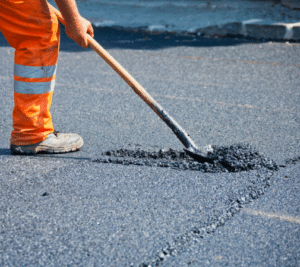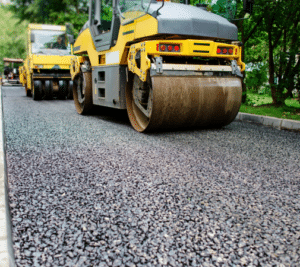If you’ve ever heard of this process, you might wonder- what is asphalt milling? Milling asphalt is a process by which asphalt pavement is restored so that it can keep being used instead of needing to be replaced. This allows the asphalt to last longer and lowers the cost of maintaining the pavement.
The Basics- What Is Asphalt Milling?
The process requires the crew to grind up the surface of the asphalt to make the surface smooth and even. The surface is then repaved. When you get asphalt milling, it saves you from needing all of the asphalt broken up, removed, and replaced. Instead, much of the original asphalt can continue to be in use, and a smaller layer of asphalt can be added to renew the asphalt. This is a significant cost saving over a complete replacement.
Crews began using this technique in the 1970s, and it has proven to be a beneficial practice that can keep paved surfaces looking and functioning better. The amount of asphalt removed from the surface varies with the condition of the asphalt. It may go down a couple of inches or deeper. The equipment used to do asphalt milling has been improved a lot since the 70s, resulting in a reliable method of restoring pavement.
Performing this service requires a cold milling machine. These machines pass over the asphalt and remove a layer up to 2″ deep with each pass. This is far less expensive and time-consuming than using equipment to break up and remove all of the asphalt.
The Asphalt Milling Process
A human drives the cold milling machine to dig up the surface of the asphalt. Milling machines come in various sizes depending on the job you need done. The milling machine has rows of teeth made from metal diagonally mounted onto the cutting drum. This drum rotates to dig up the surface 2″ of the asphalt. The machine also contains a grinder to grind up the material removed from the asphalt’s surface. This grinder crushes the millings that come away from the asphalt.
Milling asphalt also requires making the asphalt pieces much smaller so they can be used later for other projects. The milling machine contains screens that allow the crushed material to be sieved into pieces that are about 1.25″. The machine then transfers these pieces to a conveyer on the front of the milling machine. A truck drives just in front of the machine as it makes its passes over the asphalt. The millings can then be transferred to the truck that is in front of it. This will continue until the truck is full and needs to be hauled elsewhere.
It is generally taken temporarily to a stockpile where it will be ready for use in projects like the pieces used on the shoulders of roads. If the millings are used on those shoulders, they get used fast. If they aren’t, the millings will go to a maintenance depot for roadbuilders. It may also be sold to construction companies or other parties.
Benefits of Asphalt Milling
There are a lot of important benefits that are possible with milling asphalt. It is, of course, a substantial cost-saving method. It can make it possible to keep using much of the same asphalt for much longer than if it were to be removed entirely from the area. With the sub-base intact, it also takes less time to mill the asphalt than it would take to demolish and replace it.
Sometimes, a stretch of asphalt gets an overlay to restore it. This adds height to the pavement and can only be done so many times. Milling asphalt is different because it takes off a layer before adding the new asphalt. This allows the pavement to keep its same height. Adding height to it could cause logistical problems, such as drainage issues, that you won’t have to worry about with milling.
It’s also a more environmentally friendly way to take care of your paved surface. Asphalt milling takes the millings left over from the process and allows them to be recycled. This has helped asphalt in the U.S. to be one of the most commonly recycled materials. The small pieces a milling machine creates are highly useful in many construction projects. Each year, more than 100 million tons of millings are recycled for new uses in the U.S. This saves an enormous amount of materials from going to landfills every year.
You can use milling to address areas of the asphalt that have problems. If you have a parking lot or some other structure that has a problem area, you can have just that area milled and covered with a new layer of asphalt to fix it. These machines also take a specific depth of asphalt from the surface. Larger machines can dig down to deeper depths if needed. These large machines work quickly and allow the project to be done with little hassle.
It helps you have a safer, smoother paved area that won’t harm others. If you have a parking lot or driveway that is damaged and unsafe, it opens you up to liability for accidents. When you can quickly and easily get the area fixed without removing all of the asphalt, you have a great solution to the problem.
Millings can be used in both unpaved and paved roads, in parking lots, on the shoulders of roads, to add to an area covered in gravel, as backfill for culverts and trenches, and in bike paths and pathways on golf courses. If a landscaped area needs hardscape filler, millings are perfect for this task.



